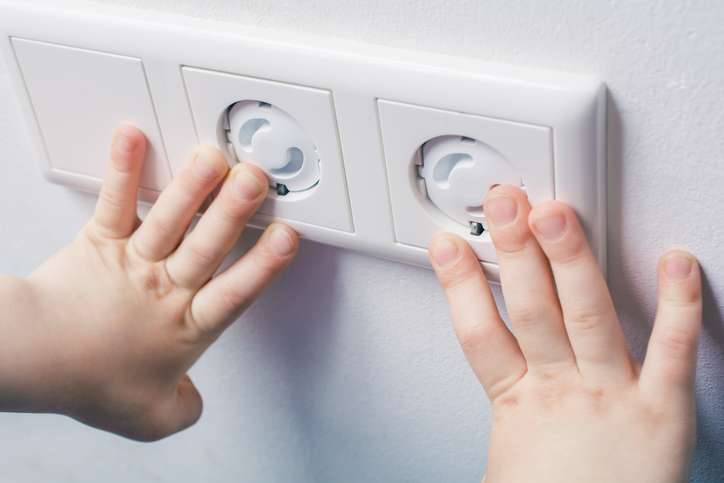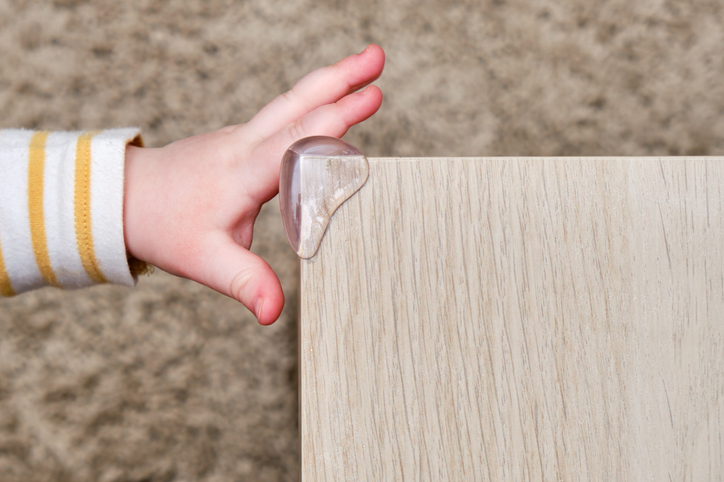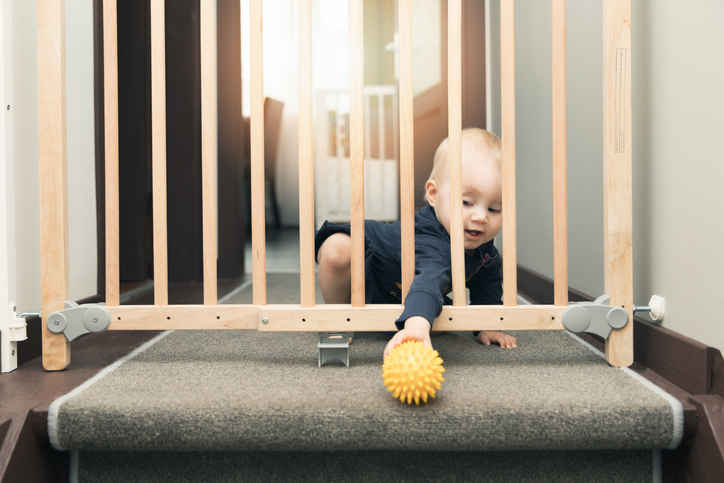Childproofing electrical outlets and cords in homes is of paramount importance to ensure the safety of young children. Electrical components can pose serious risks and hazards if left accessible to curious little ones. Children’s innate curiosity and tendency to explore their surroundings make them vulnerable to accidents involving electrical outlets and cords.
Potential hazards include electric shocks, burns, and even the risk of electrical fires if cords are damaged or mishandled. Certain areas, like living rooms, playrooms, and bedrooms, may require extra attention in childproofing efforts due to higher child activity and the presence of electrical devices.

Table of Contents
- Understanding the Electrical Hazards
- Childproofing Electrical Outlets
- Securing Electrical Cords and Cables
- Additional Safety Measures
- Guidelines, Standards, and Common Mistakes in Childproofing
- Ensuring Safety for Both Children and Pets
- Emergency Preparedness for Electrical Incidents
- Childproofing Outdoors and During Holidays
- Take Away
Parents and caregivers must recognize that even seemingly harmless electrical appliances, like phone chargers or small gadgets, can be dangerous when left within reach of children. To mitigate these risks, it’s crucial to implement effective childproofing measures that not only safeguard outlets but also address the security of electrical cords and devices. By taking proactive steps, homes can become safer environments for children to explore and play without compromising their well-being.
Understanding the Electrical Hazards
When it comes to childproofing electrical outlets and cords, be aware of the potential hazards that could pose risks to young children. Electrical outlets are designed to deliver power to various devices, and their exposed nature can be dangerous if left unsecured. Here are some key hazards to consider:
- Electric Shock – children’s curiosity may lead them to insert objects, such as fingers or metal items, into the sockets, resulting in severe or even life-threatening electric shocks.
- Tripping Hazards – cords running across floors or pathways can be tripping hazards for both children and adults which can lead to injuries.
- Fire Hazards – damaged or frayed electrical cords can potentially lead to electrical fires. Children tugging or playing with cords can weaken the insulation and lead to fires.
Certain areas of the house require extra attention when childproofing electrical outlets and cords. For instance, living rooms and playrooms are spaces where children often spend time, and as a result, the risk of accidents is higher in these areas. Bedrooms should also be childproofed, especially if electrical devices like lamps, clocks, or chargers are accessible to children.
Specific electrical appliances and devices can pose higher risks to children if not managed safely. Portable heaters, for example, should be kept out of children’s reach to prevent burns or tipping accidents. Similarly, power strips with multiple outlets should be secured or placed in childproofed areas to avoid accidental contact with exposed electrical contacts.
To manage these risks, parents and caregivers can invest in various childproofing products available in the market. Tamper-resistant outlet covers, like the ones offered by Safety 1st or Mommy’s Helper, can help prevent children from inserting objects into the sockets. These covers usually cost between $5 to $10 for a pack of six.
For managing cord-related hazards, cord organizers and clips from brands like Belkin or JOTO can be utilized to keep cords neatly secured and out of children’s reach. These organizers typically range from $8 to $15, depending on the brand and quantity.
Understanding these electrical hazards and taking appropriate childproofing measures can significantly minimize the risks associated with electrical outlets and cords in a home and ensure a safe environment.
Childproofing Electrical Outlets
Childproofing electrical outlets is a step that should be taken in any household. Childproofing outlet covers allow for a safeguard against accidental shocks and utilizing tamper-resistant electrical outlets adds an extra layer of safety. Furthermore, childproofing power strips and surge protectors should be another consideration in creating a safe environment for your child.
Childproof Outlet Covers
Childproof outlet covers come in various designs, such as sliding plate covers, plug-in caps, and swivel outlet covers and are tools for to minimize the risk of accidental shocks or injuries to children. They serve as barriers, preventing children from accessing the electrical contacts inside the sockets. Proper installation is crucial for their effectiveness. After inserting the cover into the outlet, gently tug on it to ensure it is securely in place. Some covers have adhesive backing or require screws for added stability. Follow the manufacturer’s instructions carefully for installation, and periodically check the covers to ensure they are still secure.
Tamper-Resistant Electrical Outlets
Tamper-resistant electrical outlets (TRR outlets) provide an additional layer of protection against child access. They feature built-in shutters that block access to the electrical contacts unless equal pressure is applied simultaneously to both openings. This design effectively prevents children from inserting objects into the slots, significantly reducing the risk of electrical shock. TRR outlets are a permanent and more secure solution compared to outlet covers, which may be removed or forgotten. Brands like Leviton and Legrand offer tamper-resistant outlets that comply with safety standards and regulations.
Childproofing Power Strips and Surge Protectors
Power strips and surge protectors provide multiple outlets for various devices. To childproof these units, specially designed covers or boxes can be utilized. Power strip covers fit over the entire power strip, shielding it from curious hands. These covers usually feature adjustable openings to accommodate cords and prevent accidental unplugging. Another option is to use cord organizers to keep excess cords neatly tucked away and out of reach. Ensuring that power strips and surge protectors are mounted securely to walls or furniture can also minimize the risk of tipping or pulling on cords.
By employing these childproofing measures, parents and caregivers can create a safer environment, protecting children from potential electrical accidents and providing peace of mind.
Securing Electrical Cords and Cables
Securing electrical cords and cables is a vital aspect of childproofing homes and minimizing potential hazards. Preventing children from pulling on electrical cords can help avoid accidents and injuries. Cord organizers and clips from brands like Belkin or JOTO are effective tools to keep cords neatly secured and out of children’s reach. Regularly inspecting cords for wear and tear is essential, as damaged cords should be promptly replaced to ensure safety.
In the case of a frayed or damaged electrical cord in a child-accessible area, immediate action is necessary. The cord should be unplugged from the outlet and replaced with a new one to prevent potential electric shocks or fires. Educating children about electrical safety is another critical aspect of childproofing. Teaching them to respect electricity, avoid playing with switches or plugs, and informing them about the risks of mishandling electrical devices empowers children to make safer choices.
Parents and caregivers must also consider the functionality of childproofing measures. Well-designed outlet covers and cord organizers should not hinder the regular use of electrical outlets or devices. They should be easy for adults to access while being challenging for children to remove. By effectively securing electrical cords and teaching children about electrical safety, homes can become safer environments for children to explore and play without unnecessary hazards.
Additional Safety Measures
When assessing your house’s safety and minimizing electrical threats, there are various recommended guidelines and maintenance tips and tools to follow. It is also important to be aware of how other members of your household may be affected and to be prepared for any instances that may occur.
Guidelines, Standards, and Common Mistakes in Childproofing
The American Academy of Pediatrics (AAP) recommends using tamper-resistant electrical outlets, such as those offered by Leviton or Safety 1st, to reduce the risk of electrical injuries. These outlets have built-in shutters that prevent the insertion of foreign objects, providing a higher level of safety compared to standard outlets. It’s also essential to choose high-quality childproof outlet covers and cord organizers, like the ones from Mommy’s Helper or Cable Concealer, which fit securely and are tested for safety.
Avoid common mistakes that might compromise the effectiveness of your efforts by not using outlet covers that are too easily removable by children. To ensure maximum protection, choose covers that require a bit of dexterity to remove, but that adults can open with ease. Additionally, never use damaged or worn-out outlet covers or cords, as they can jeopardize the safety measures in place. Any damaged components should be promptly replaced with new ones to maintain safety standards.
Regular Maintenance, Updates, and Creative Cord Management
Conduct periodic inspections of outlet covers, cord organizers, and power strip covers to ensure they are still secure and functioning correctly. As children become more aware of their surroundings, ongoing education about electrical safety is essential for reinforcing good habits.
Hiding or disguising electrical cords can enhance both safety and aesthetics in child-friendly environments. Cord covers, cable management boxes, and decorative tape can be utilized to conceal cords along walls and baseboards while keeping them organized and out of sight. Cord clips with playful designs can also complement the room’s décor while ensuring cords are securely bundled and inaccessible to children.
Ensuring Safety for Both Children and Pets
Childproofing measures can also benefit the safety of pets in the home. Similar to children, pets can be curious and may pose risks around electrical outlets and cords. By employing outlet covers and cord organizers, pet owners can prevent their furry companions from accessing outlets and pulling on cords. Keeping cords well-organized and out of pets’ reach can further prevent chewing or other forms of damage.
Emergency Preparedness for Electrical Incidents
Take immediate action in the event of an electrical incident involving children. Instruct adults to turn off the power at the circuit breaker promptly. If a child is unconscious or having difficulty breathing, call emergency services (911) and administer CPR if trained to do so. Knowing the location of the circuit breaker and having a clear emergency plan ensures quick and appropriate responses to such incidents.
By combining these safety measures, parents can effectively childproof electrical outlets and cords, creating a secure environment for their children and pets. Adhering to guidelines, avoiding common mistakes, maintaining and updating childproofing measures, and being prepared for emergencies all contribute to a safer living space for the entire family.
Childproofing Outdoors and During Holidays
Childproofing efforts should extend beyond indoor spaces to include outdoor electrical outlets and holiday decorations. Outdoor outlets can present unique challenges, especially with exposure to weather conditions. Rain, snow, and debris can make these outlets potential hazards for children. To childproof outdoor outlets effectively, weatherproof outlet covers or in-use outlet covers from reputable brands like TayMac or Sealproof can be used. These durable covers provide essential protection, shielding the outlets from the elements while still allowing convenient access for plugs when needed.
During holidays and festive seasons, electrical decorations can add cheer to homes, but they also introduce additional electrical hazards. Childproofing holiday decorations becomes crucial to ensure a safe and joyful celebration. One key measure is securing the decorations properly to prevent children or pets from pulling them down accidentally. Using zip ties or clips to keep cords and lights neatly fastened can minimize the risk of entanglement and tripping hazards.
Inspect lights and cords before hanging them up. Look for any signs of damage, such as frayed wires or broken sockets, and promptly discard any decorations that are compromised. Replacing damaged decorations with new ones will help avoid potential electrical hazards. It’s also crucial to use outdoor-rated lights specifically designed to withstand weather conditions. Brands like Philips and Enbrighten offer reliable outdoor-rated lights that can endure rain, snow, and other environmental factors without compromising safety.
Opting for low-voltage LED lights can be a safer choice, as they generate less heat and are less likely to cause burns if touched by curious little hands. When using extension cords for outdoor decorations, choose outdoor-rated cords with sufficient capacity to handle the lights or decorations you plan to use. Keeping extension cords away from high-traffic areas, like walkways or play areas, can prevent tripping accidents.
Always supervise children around electrical decorations, especially those that involve lit candles or other heat sources. Establish clear guidelines for children about interacting with holiday decorations to prevent accidents and injuries.
Applying childproofing strategies to outdoor electrical outlets and holiday decorations allows for parents to ensure a safer and more enjoyable environment for children during special occasions and festivities. Being mindful of potential hazards and taking proactive steps to childproof these areas allows families to celebrate with peace of mind, knowing that they have taken the necessary precautions to reduce the risks associated with electrical components outdoors.
Take Away
Childproofing electrical outlets and cords is crucial to create a safe environment for children, minimizing the risks of electric shocks, burns, and fire hazards. Utilizing childproof outlet covers, cord organizers, and tamper-resistant electrical outlets, along with staying proactive in maintenance and educating children about electrical safety, enhances their protection. By following these measures, parents can ensure a worry-free home environment where children can explore and play safely.




